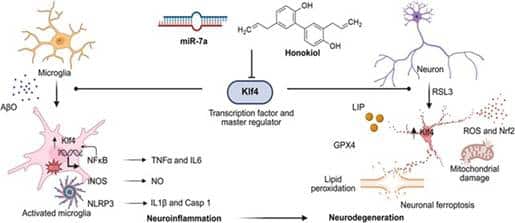Towards a Potential Cure for Alzheimer’s Disease

Alzheimer’s Disease (AD), a condition that severely impacts cognitive functions and daily living, may soon see groundbreaking advancements in treatment and potential cures. Researchers from the Jawaharlal Nehru Centre for Advanced Scientific Research (JNCASR) have identified a novel therapeutic target involving microRNAs (miRNAs) and small molecules, which could significantly expedite the drug discovery process. This innovative approach aims to address the pressing need for effective treatments for a disease that currently affects millions worldwide and is projected to increase in prevalence.
Understanding Alzheimer’s Disease
Alzheimer’s Disease is a progressive neurological disorder that accounts for 70-80% of dementia cases and ranks as the fifth leading cause of death globally. Characterized by memory loss, cognitive decline, and the accumulation of protein clumps in the brain, AD poses a significant socioeconomic burden on healthcare systems and society at large. Despite the urgency for effective treatments, current therapeutic options are limited, primarily offering only temporary relief. Recently approved antibody-based drugs have shown limited efficacy, underscoring the need for more effective solutions. The role of proteins in AD has been extensively studied; however, the impact of microRNAs, which play a crucial role in gene regulation, remains poorly understood.
Research Breakthroughs at JNCASR
In a bid to unravel the complexities of Alzheimer’s Disease, researchers at JNCASR have focused on the altered expression of miRNAs in the brains of AD patients. Their study utilized a double transgenic AD mouse model to identify specific miRNAs that are significantly altered in the context of the disease. This research, published in *NAR Molecular Medicine*, highlights various miRNA-mRNA pathway networks that could serve as potential targets for drug development. Among their findings, the researchers noted a marked increase in miR-7a, which targets Klf4, a key regulator of gene expression associated with AD. This discovery is pivotal as it links miR-7a to neuroinflammation and ferroptosis, both of which are critical factors in AD pathology.
Innovative Therapeutic Approaches
The researchers have developed a miRNA-based therapeutic strategy aimed at targeting Klf4 to mitigate neuroinflammation and ferroptosis. By synthesizing a modified version of miR-7a, they successfully silenced Klf4 levels, which in turn alleviated disease-related pathologies. The study also explored the use of Honokiol, a natural compound derived from the Magnolia tree, which has shown promise in pharmacologically modulating the miR-7a-Klf4 axis. This innovative approach not only demonstrates the potential of targeting this axis for therapeutic benefits but also opens avenues for further research into effective treatments for Alzheimer’s Disease.
Future Implications and Potential Impact
The implications of this research are profound. If the miRNA mimic and small molecule prove to be safe and effective in clinical evaluations, they could revolutionize the treatment landscape for Alzheimer’s Disease, offering hope to millions of patients and their caregivers. Additionally, the study has identified a panel of upregulated and downregulated miRNAs that may serve as biomarkers for early clinical diagnosis of AD. This could lead to earlier interventions, significantly reducing the socioeconomic burden associated with the disease. Overall, this groundbreaking research not only paves the way for new therapeutic strategies but also contributes to the broader understanding of neurodegenerative and neuroinflammatory disorders.
Observer Voice is the one stop site for National, International news, Sports, Editor’s Choice, Art/culture contents, Quotes and much more. We also cover historical contents. Historical contents includes World History, Indian History, and what happened today. The website also covers Entertainment across the India and World.
Follow Us on Twitter, Instagram, Facebook, & LinkedIn

